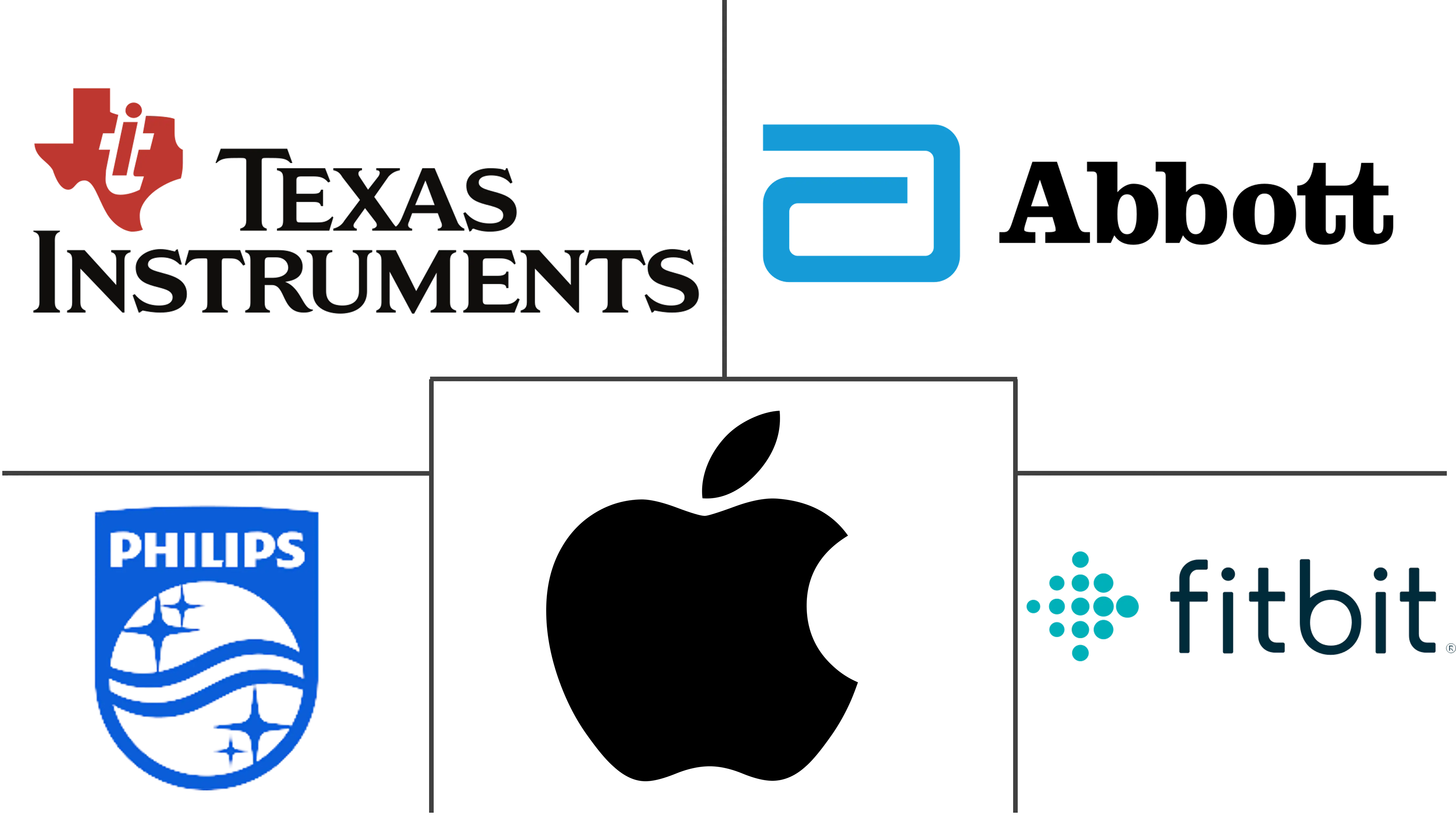Body Sensor Market Size and Share
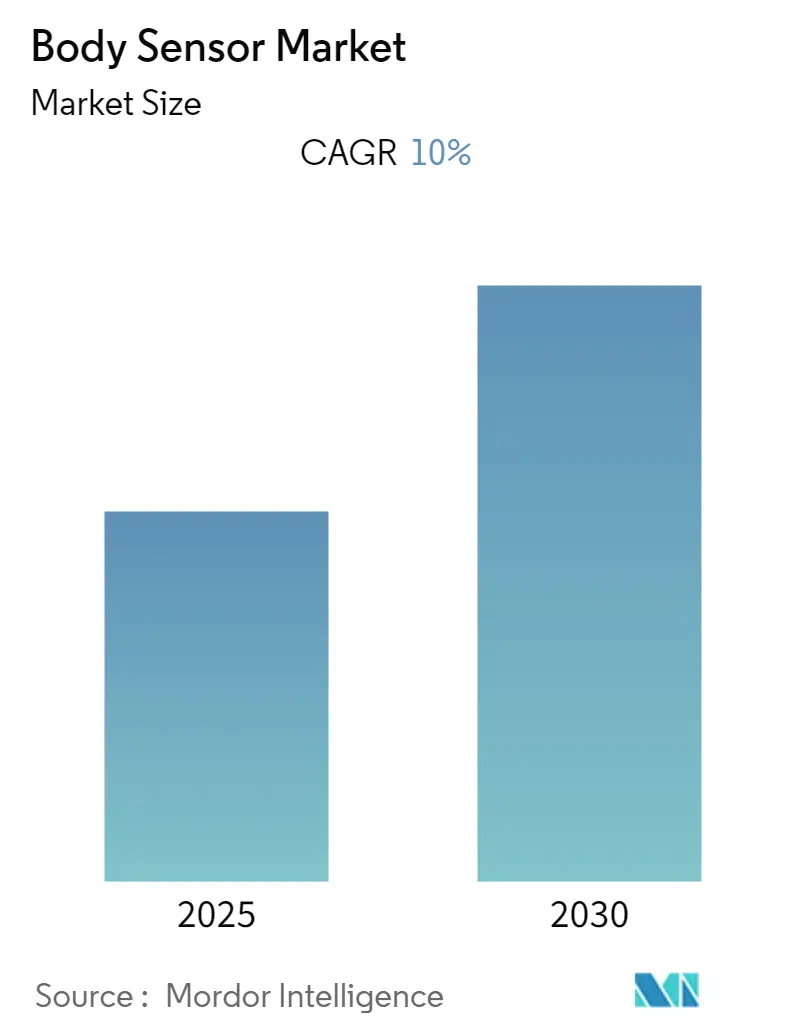
Body Sensor Market Analysis by Mordor Intelligence
The Body Sensor Market is expected to register a CAGR of 10% during the forecast period.
During the COVID-19 pandemic, the studied market was significantly impacted. The demand for health monitoring became crucial due to interlinking life-threatening conditions of the COVID-19 infection. For instance, according to the article published by ScienceDirect in December 2021, to record and process health data remotely, sensors have been successfully integrated with smartphones, smart wearables, and the internet of medical things (IoMT). During the COVID-19 epidemic, sensors continued to revolutionize healthcare systems globally and provided the new potential for virtual treatment. This argues for a considerable adoption of body sensors during the pandemic. Therefore, the COVID-19 pandemic has significantly impacted the studied market in its preliminary phase. However, as the pandemic has subsided currently, the market is expected to have stable growth during the forecast period of the study.
Factors such as a rise in the geriatric population, increasing disposable income, and increasing research and development in health technology are expected to fuel the market growth over the forecast period.
The increase in the geriatric population is expected to be a major contributor to the studied market. According to the data published by UN in 2022, it is estimated that the population aged 65 years and above is 10% in 2022, and it is expected to rise to 16% by 2050. This target population is more prone to getting age-related chronic and life-threatening diseases. The increase in the number of geriatrics demands better monitoring facilities in the hospital operating rooms and outside. Thereby driving the demand for body sensors.
Furthermore, as per the article published by PubMed in July 2022, the use of sensors evolved in two different ways: by externally attaching them and by implanting them as an implantable sensors. Where the sensors follow their operating principles for a certain application, each method has its benefits. As per the source mentioned above, various wearable sensors have been utilized for personalized healthcare, demonstrating their effectiveness in monitoring various diseases and the continuous collection of data for a considerable amount of time. Thus, the development of body sensors for healthcare purposes is fueling market growth.
Moreover, continuous product innovation and launches are contributing to market growth. For instance, in February 2022, Senseonics Holdings, Inc., a medical technology company focused on the development and manufacturing of long-term, implantable continuous glucose monitoring (CGM) systems for people with diabetes, received the approval of the next-generation Eversense E3 CGM System by the FDA. The Eversense E3, including proprietary sacrificial boronic acid (SBA) technology, can extend longevity to 6 months. Thus, the developments in the market are anticipated to boost market growth over the analysis period.
Therefore, due to the factors mentioned above such as the continuous product innovation and launches, the development of body sensors for healthcare purposes, and the rising geriatric population, the studied market is anticipated to witness growth during the forecast period. However, the lack of awareness about the products and stringent regulatory guidelines for product approval are predicted to restrain the growth of the market.
Global Body Sensor Market Trends and Insights
Wearable Segment is Expected to Witness a Significant Growth Over the Forecast Period
The wearable sensors are built into clothing or are attached directly to the body to monitor health and offer therapeutically useful information for treatment. The internet of things (IoT) concept enables medical support at home through a monitoring system connected to a hospital. Consequently, a variety of sensors can be used (e.g., GPS receiver, accelerometer, ECG, blood pressure, blood glucose, body temperature, and breathing sensor). Thus, owing to the advantages of wearable sensors to track useful medical information, and the increase in product developments, the segment is expected to grow over the forecast period.
According to the article published by Nature in July 2022, by utilizing a variety of physical, chemical, and biological sensors to determine physiological (biophysical and/or biochemical) information in real-time (ideally continuously), non-invasive, or minimally invasive ways, wearable devices offer an alternative avenue to clinical diagnostics. The source above also suggested that the high-resolution and time-resolved historical recording of a person's health condition is made possible by next-generation wearable sensors that enable the multimodal and/or multiplexed assessment of physical parameters and biochemical markers continuously and in real time. Hence, owing to such benefits, the segment is witnessing demand, thereby, contributing to the segment growth.
The frequent developments in the segment are the major contributors to the segment's growth. Such as, in December 2021, Huawei launched its new Huawei Watch D with blood pressure, ECG monitoring, and aviation aluminum body. But as per the company press release, the blood pressure monitoring feature of the wearable is the main highlight. In addition, in November 2021, Respira Labs, a company focused on respiratory healthcare technology launched an AI-powered wearable lung monitor. The wearable could help with the early diagnosis and management of chronic obstructive pulmonary disease (COPD), asthma, and COVID-19. Thus, these developments are predicted to contribute to the market growth over the forecast period.
Therefore, owing to the factors mentioned above such as the advantages of wearable sensors and the frequent developments by key market players, the segment is expected to witness growth over the forecast period.
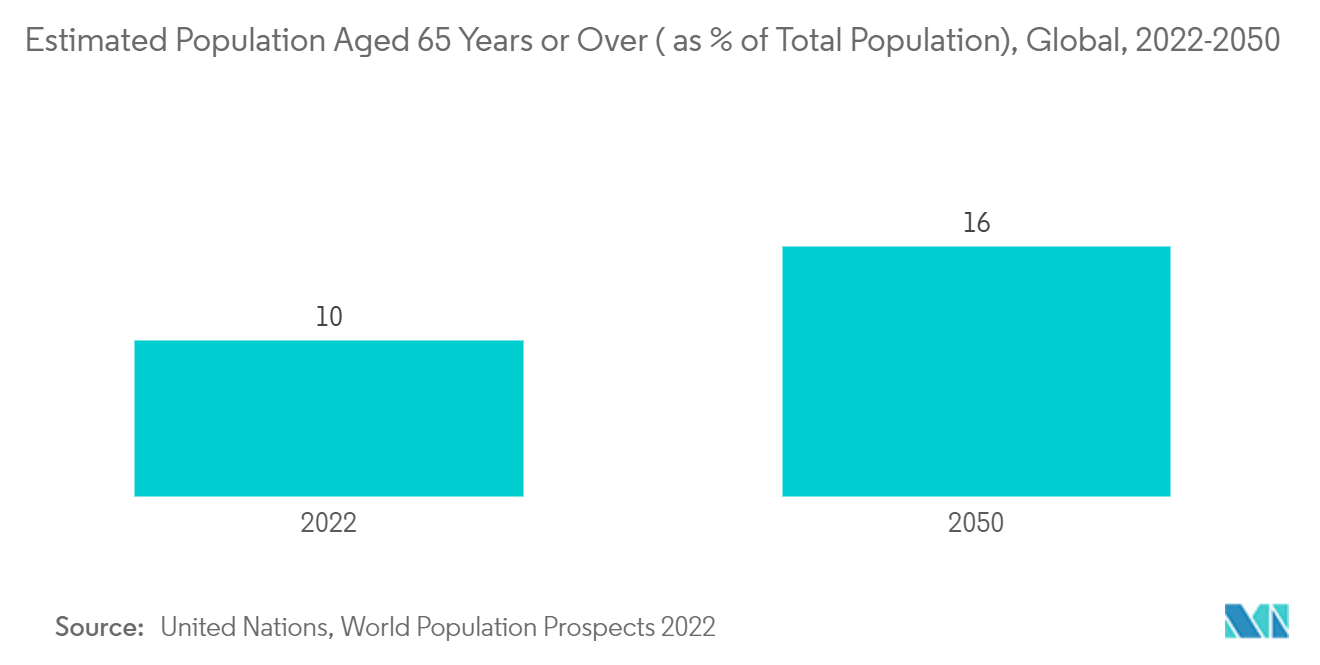
North America is Expected to Hold a Significant Share of the Market Over the Forecast Period
Due to the increasing involvement of market players in product innovation and product approvals, North America is one of the major contributors to the studied market.
A rise in the geriatric population in countries across North America is a major contributor to the studied market in the region. For instance, according to the data published by the World Bank Group in 2022, the population aged 65 and above as a percentage of the total population was 17.04% in the United States in 2021, 18.56% in Canada, and 7.83% in Mexico. In addition, according to a press release by the government of Canada in April 2022, the number of people aged 65 or more increased drastically to 7 million in 2021, which is the second-largest increase in the past 75 years. The age group of 65 years or older represented approximately 1 in 5 Canadians or approximately 19% of the total population. As this population is prone to life-threatening chronic and infectious diseases, the increase in the number of geriatrics demands better monitoring facilities. This is creating demand for body sensors for monitoring their health information. Thus, it is expected to drive market growth in the region.
Furthermore, according to the data published by Diabetes Canada in February 2022, it is estimated that around 11,704,000 people are living with diabetes and prediabetes in Canada in 2022. Thus, the high prevalence of diabetes is also expected to increase the adoption of body sensors.
Moreover, the increasing focus of market players for new product innovations and patent acquisitions, are driving the overall, market growth. For instance, in June 2022, the United States-based wearable brand Garmin registered a patent with the United States Patent and Trademark Office (USPTO) for a watch that can track both ECG and potentially blood pressure. Such developments are anticipated to contribute to the market growth over the forecast period.
Therefore, owing to the aforesaid factors such as the increasing geriatric population in the region and the increasing focus of market players for new product innovations and patent acquisitions, North America is expected to hold a significant share the market over the forecast period.
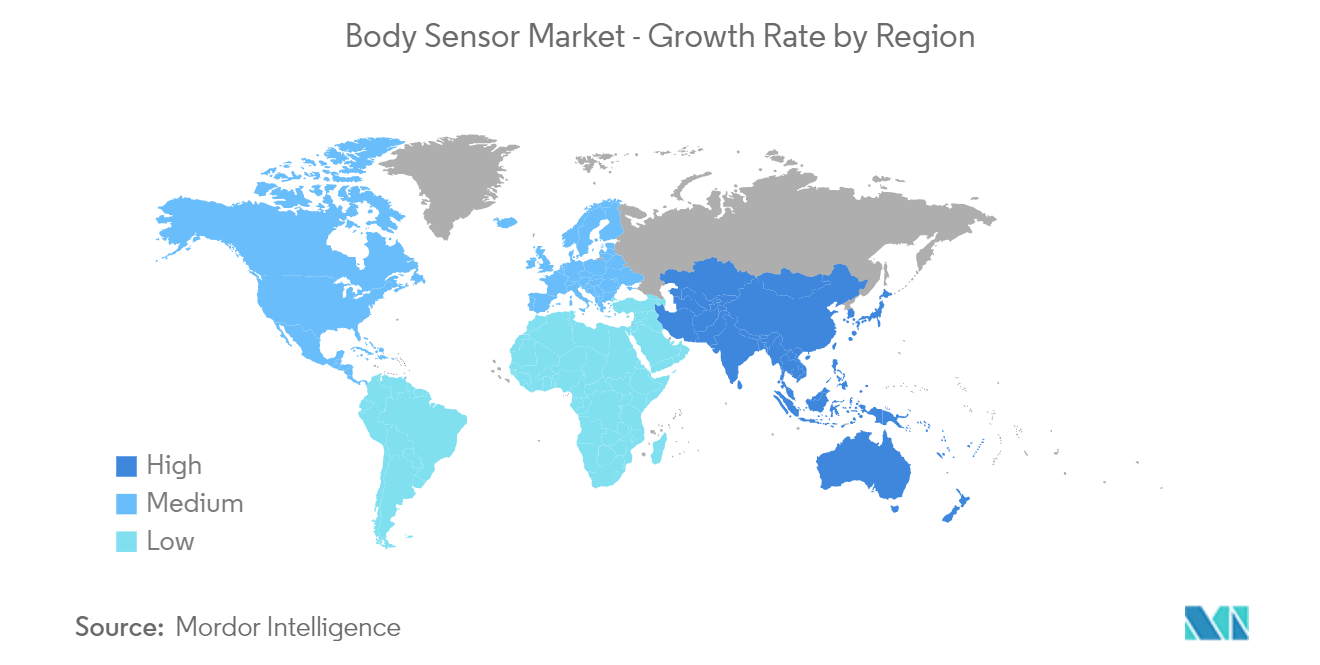
Competitive Landscape
The body sensor market is fragmented in nature. The major players in the market focus on continuous product development, especially in developing countries. Major market players are focused on continuous mergers and acquisitions to expand their market presence. A few of the major players in the market are Abbott Laboratories, Apple Inc., ASC GmbH, Fitbit, Inc., Garmin Ltd., Koninklijke Philips N.V., NXP Semiconductors N.V., STMicroelectronics, Texas Instruments Incorporated, Huawei Technologies Co., Ltd., Samsung Electronics Co., Ltd., and Meta Materials Inc., among others.
Body Sensor Industry Leaders
-
Abbott Laboratories
-
Apple Inc.
-
Fitbit, Inc.
-
Texas Instruments
-
Koninklijke Philips N.V.
- *Disclaimer: Major Players sorted in no particular order
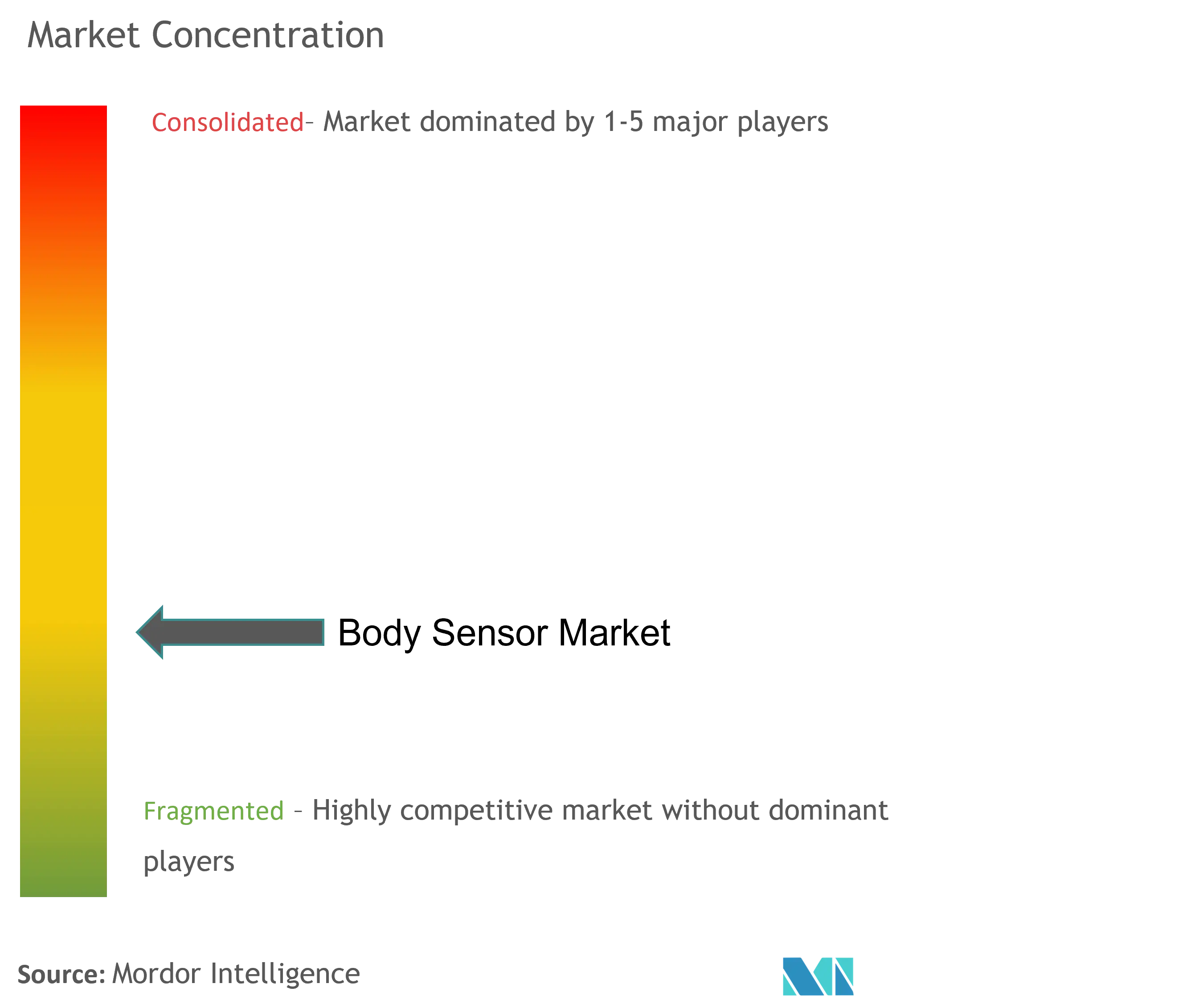
Recent Industry Developments
- In December 2022, North Edge launched a smartwatch called the North Edge ECG smartwatch. It has a built-in ECG heart rate monitor, which can be used to measure heart rate, blood pressure, and blood oxygen levels. The company also claims that there is a body temperature sensor onboard.
- In November 2022, Nanoleq, a swiss company launched the Oxa breathing wearable via a crowdfunding campaign on Kickstarter. The latest product has features such as real-time biofeedback for health metrics like breathing depth and speed.
Global Body Sensor Market Report Scope
As per the scope of the report, body sensors are used for monitoring blood pressure, respiration, temperature, and other vital parameters of the body. These sensors are related to wearable computing devices. It can be installed within the body implants or can be surface mounted within the body. The Body Sensor Market is segmented by Type (Blood Pressure Sensor, Respiration Sensor, Temperature Sensor, ECG Sensor and Others), Placement Type (Wearable and Implantable), and Geography (North America, Europe, Asia-Pacific, Middle East and Africa, and South America). The market report also covers the estimated market sizes and trends for 17 countries across major regions globally. The report offers the value (in USD million) for the above segments.
| Blood Pressure Sensor |
| Respiration Sensor |
| Temperature Sensor |
| ECG Sensor |
| Others |
| Wearable |
| Implantable |
| North America | United States |
| Canada | |
| Mexico | |
| Europe | Germany |
| United Kingdom | |
| France | |
| Italy | |
| Spain | |
| Rest of Europe | |
| Asia-Pacific | China |
| Japan | |
| India | |
| Australia | |
| South Korea | |
| Rest of Asia-Pacific | |
| Middle East and Africa | GCC |
| South Africa | |
| Rest of Middle East and Africa | |
| South America | Brazil |
| Argentina | |
| Rest of South America |
| By Type | Blood Pressure Sensor | |
| Respiration Sensor | ||
| Temperature Sensor | ||
| ECG Sensor | ||
| Others | ||
| By Placement Type | Wearable | |
| Implantable | ||
| Geography | North America | United States |
| Canada | ||
| Mexico | ||
| Europe | Germany | |
| United Kingdom | ||
| France | ||
| Italy | ||
| Spain | ||
| Rest of Europe | ||
| Asia-Pacific | China | |
| Japan | ||
| India | ||
| Australia | ||
| South Korea | ||
| Rest of Asia-Pacific | ||
| Middle East and Africa | GCC | |
| South Africa | ||
| Rest of Middle East and Africa | ||
| South America | Brazil | |
| Argentina | ||
| Rest of South America | ||
Key Questions Answered in the Report
What is the current Body Sensor Market size?
The Body Sensor Market is projected to register a CAGR of 10% during the forecast period (2025-2030)
Who are the key players in Body Sensor Market?
Abbott Laboratories, Apple Inc., Fitbit, Inc., Texas Instruments and Koninklijke Philips N.V. are the major companies operating in the Body Sensor Market.
Which is the fastest growing region in Body Sensor Market?
Asia Pacific is estimated to grow at the highest CAGR over the forecast period (2025-2030).
Which region has the biggest share in Body Sensor Market?
In 2025, the North America accounts for the largest market share in Body Sensor Market.
What years does this Body Sensor Market cover?
The report covers the Body Sensor Market historical market size for years: 2019, 2020, 2021, 2022, 2023 and 2024. The report also forecasts the Body Sensor Market size for years: 2025, 2026, 2027, 2028, 2029 and 2030.
Page last updated on:
Body Sensor Market Report
Statistics for the 2025 Body Sensor market share, size and revenue growth rate, created by Mordor Intelligence™ Industry Reports. Body Sensor analysis includes a market forecast outlook for 2025 to 2030 and historical overview. Get a sample of this industry analysis as a free report PDF download.
